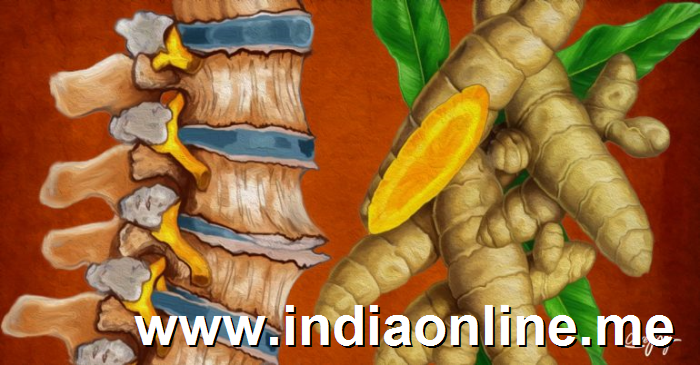Published on: 1/6/2018IST
Natural Treatments For Degenerative Disc Disease

Degenerative disc disease is the term used to describe wear and tear that occurs in your spine as you age. In some people this can cause neck or back pain. Applying heat or ice can help ease the pain. Maintaining a proper posture and losing excess weight can help ease stress on your spinal discs. Physical exercises and yoga can also help. Boswellia, ginger, and turmeric may ease pain.
All that wisdom you gain with passing years may come at the cost of a few aches and pains as your body ages. The wear and tear from a lifetime of daily, random activities affects your spine as well and fall under the category of degenerative disc disease.
Your Spinal Discs Deteriorate With Age
Your spinal discs are compressible soft discs which separate the bones that make up your spine. They allow your spine to bend, flex, and twist and act as shock absorbers. Degenerative disc disease can occur throughout your spine, but it typically takes place in the discs in your neck and lower back. People who engage in heavy physical work, smoke, or are obese are more likely to experience degeneration of their spinal discs. An injury that results in a herniated disc may also start off the degeneration process.
While this process affects everyone, it gets flagged only when painful symptoms arise. This may be chronic pain in your lower back, which may then radiate to your hips. Or it may appear as pain in your thighs or buttocks while walking. The pain could worsen when you reach up, bend over, or twist. Constant pain in your neck which may radiate to your arms and shoulders can also be a symptom. A weakness or tingling in the knees is also common. Changes in your spinal discs may also lead to osteoarthritis, where the tissue that cushions and protects your joints breaks down; herniated disc, where a spinal disc breaks open or bulges abnormally; or spinal stenosis, where the spinal canal which holds your spinal cord becomes narrow.
Your doctor may prescribe medication to tackle the symptoms of this condition. For instance, if you experience pain you may be given nonsteroidal anti-inflammatory drugs or other painkillers for relief. In some cases surgical treatments such as the removal of a damaged disc may be recommended. But you can also manage the pain and other discomfort with some natural treatments and techniques.
1. Apply Hot Or Cold Packs For Pain Relief
Applying hot or cold packs can ease pain linked to degenerative disc disease. Warm compresses or heating pads can soothe areas that hurt and relax your muscles. You could also try hot showers or baths. Treating the area to a cold pack can bring about a numbing effect that relieves pain. Wrap the ice pack in a towel before you apply it though – applying ice directly on your skin might cause an ice burn. Try both cold and hot treatments to see what works best for you.
2. Correct Your Posture
Poor posture can stress your spinal discs and lead to joint compression and muscular fatigue. Learning healthier ways of sitting, standing, lifting objects, and sleeping can help ease back pain. Follow these tips for good posture:
While sitting: Your upper back should be straight and your shoulders relaxed. Tightening your buttocks and stomach will help you keep your abdomen muscles pulled in while still maintaining the natural curve of your lower back. You can also use a small cushion behind your lower back to help you do this. Make sure your knees are slightly above your hips and keep your feet flat on the floor. Use a footstool if necessary.
While standing: Keep your weight balanced equally on both your feet and don’t lock your knees. If you need to stay on your feet for long periods, make sure you wear low heeled shoes or flats.
While sleeping: Lying on your side with your knees bent can help with lower back pain. Placing a pillow between the knees might also make you feel more comfortable. Also, remember to use a firm mattress.
While lifting objects: You also need to maintain good posture while you’re in motion. So when you lift something, you hold it close to your body and lift with your legs. This means that you maintain the normal curves of your back are maintained and the load is lifted by your legs. Also, when bending down to lift something you should bend your knees rather than your back. Then all you need to do to lift the object is straighten your legs.
3. Lose Weight If You’re Overweight
Extra pounds can put additional strain and pressure on your stomach and back muscles, causing them to weaken. This makes it difficult for them to support your back and even throws your posture off. And a few joints and muscles end up having to do all the work, stressing them out. So maintaining a healthy weight is important for reducing stress on spinal discs.
4. Exercise
Even if weight management isn’t an issue, exercise is important for keeping your back limb and strong. Your physical therapist can help strengthen and stretch the right muscles to help heal your back. A good exercise session might include a warm-up, aerobic exercises, and exercises which work on certain muscle groups such as abdominal muscles and the lower back.
5. Practice Yoga
Yoga, an ancient discipline which originated in India, involves practices such as breathing practices, the use of body postures, and meditation. One study compared the development of degenerative disc disease in the spines of people who had been practicing yoga for a long time with those who didn’t practice yoga. And magnetic resonance imaging found that long-term yoga practitioners had significantly less degenerative disc disease than the control group. An experienced yoga practitioner will guide you through a suitable regimen. Asanas you should incorporate include adho mukha svanasana or downward facing dog pose, balasana or child’s pose, and marjarasana or cat’s pose. Get out your yoga mat and keep your spine happy!
6. Consume Fish Oil
Nonsteroidal anti-inflammatory drugs (NSAIDs) are commonly used to tackle back and neck pain. But fish oil may prove to be a natural alternative to this. Fish oil contains omega-3 fatty acids which have anti-inflammatory effects. One study found that when people with neck or back pain took omega 3 fatty acids, 59% of them discontinued the NSAID prescribed to them for pain relief. Studies have also found that omega 3 fatty acids are comparable to the common NSAID ibuprofen at relieving pain. Fatty fish such as tuna, sardine, mackerel, and salmon naturally contain omega 3 fatty acids.
7. Have Boswellia
The gum resin of Indian frankincense or Boswellia serrata is known to reduce inflammation and ease pain. Boswellic acids present in it are thought to give it these beneficial properties. Research indicates that it’s helpful for people with osteoarthritis, a condition that can develop as a complication of degenerative disc disease. It can not only improve pain and function but may also slow down cartilage damage. Standardized extracts of boswellia containing 150 mg of boswellic acids are recommended thrice a day for about 8 weeks. You might find this remedy useful if you’re suffering from degenerative disc disease too.
8. Drink Ginger Tea
Ginger is famous for its anti-inflammatory properties. One study found that patients with osteoarthritis experienced significant pain relief as well as a reduction in an index that looked at its symptoms. Steep ginger powder or freshly grated ginger in boiling water to make a cup of pain-relieving ginger tea and have this 2–3 times a day.
9. Include Turmeric In Your Diet
Another herb that’s known for its anti-inflammatory properties is turmeric. It has also been found to be helpful for people with osteoarthritis. In fact, one study found it to comparable to ibuprofen at providing pain relief. A compound known as curcumin present in turmeric is thought to be responsible for its anti-inflammatory effects. Add this beneficial spice to your daily cooking. You could also brew a healing turmeric tea by steeping some turmeric powder in boiling water. Sweeten with honey and drink up a couple of times a day.
10. Try Acupuncture
Acupuncture, a practice used in traditional Chinese medicine, has been found to be useful in treating back pain associated with degenerative disc disease. According to ancient Chinese wisdom, your life force flows along your body through pathways known as meridians. Any imbalance or blockage in the flow of this energy can cause disease. And the practice of acupuncture corrects imbalances by inserting fine needles at specific body points known as acupoints. Be sure to consult a certified practitioner to guide you through the treatment.
1/7/2018 | | Permalink
